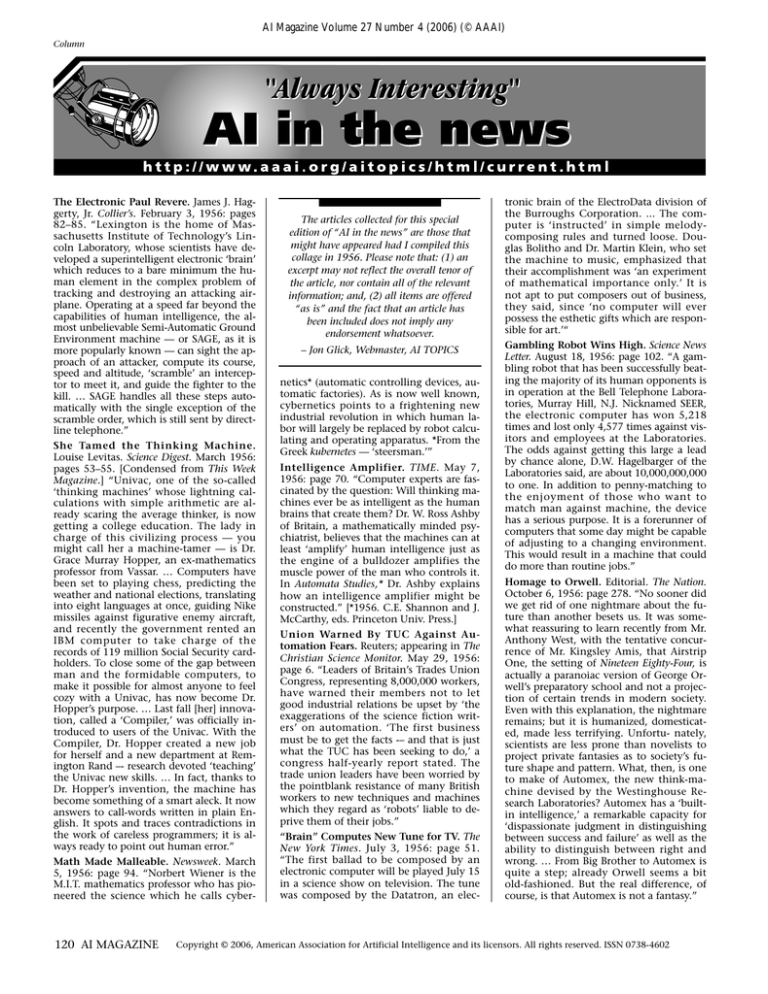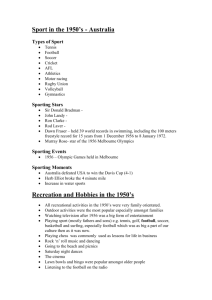
AI Magazine Volume 27 Number 4 (2006) (© AAAI)
Column
The Electronic Paul Revere. James J. Haggerty, Jr. Collier’s. February 3, 1956: pages
82–85. “Lexington is the home of Massachusetts Institute of Technology’s Lincoln Laboratory, whose scientists have developed a superintelligent electronic ‘brain’
which reduces to a bare minimum the human element in the complex problem of
tracking and destroying an attacking airplane. Operating at a speed far beyond the
capabilities of human intelligence, the almost unbelievable Semi-Automatic Ground
Environment machine — or SAGE, as it is
more popularly known — can sight the approach of an attacker, compute its course,
speed and altitude, ‘scramble’ an interceptor to meet it, and guide the fighter to the
kill. … SAGE handles all these steps automatically with the single exception of the
scramble order, which is still sent by directline telephone.”
She Tamed the Thinking Machine.
Louise Levitas. Science Digest. March 1956:
pages 53–55. [Condensed from This Week
Magazine.] “Univac, one of the so-called
‘thinking machines’ whose lightning calculations with simple arithmetic are already scaring the average thinker, is now
getting a college education. The lady in
charge of this civilizing process — you
might call her a machine-tamer — is Dr.
Grace Murray Hopper, an ex-mathematics
professor from Vassar. … Computers have
been set to playing chess, predicting the
weather and national elections, translating
into eight languages at once, guiding Nike
missiles against figurative enemy aircraft,
and recently the government rented an
IBM computer to take charge of the
records of 119 million Social Security cardholders. To close some of the gap between
man and the formidable computers, to
make it possible for almost anyone to feel
cozy with a Univac, has now become Dr.
Hopper’s purpose. … Last fall [her] innovation, called a ‘Compiler,’ was officially introduced to users of the Univac. With the
Compiler, Dr. Hopper created a new job
for herself and a new department at Remington Rand –- research devoted ‘teaching’
the Univac new skills. … In fact, thanks to
Dr. Hopper’s invention, the machine has
become something of a smart aleck. It now
answers to call-words written in plain English. It spots and traces contradictions in
the work of careless programmers; it is always ready to point out human error.”
Math Made Malleable. Newsweek. March
5, 1956: page 94. “Norbert Wiener is the
M.I.T. mathematics professor who has pioneered the science which he calls cyber-
120 AI MAGAZINE
The articles collected for this special
edition of “AI in the news” are those that
might have appeared had I compiled this
collage in 1956. Please note that: (1) an
excerpt may not reflect the overall tenor of
the article, nor contain all of the relevant
information; and, (2) all items are offered
“as is” and the fact that an article has
been included does not imply any
endorsement whatsoever.
– Jon Glick, Webmaster, AI TOPICS
netics* (automatic controlling devices, automatic factories). As is now well known,
cybernetics points to a frightening new
industrial revolution in which human labor will largely be replaced by robot calculating and operating apparatus. *From the
Greek kubernetes — ‘steersman.’”
Intelligence Amplifier. TIME. May 7,
1956: page 70. “Computer experts are fascinated by the question: Will thinking machines ever be as intelligent as the human
brains that create them? Dr. W. Ross Ashby
of Britain, a mathematically minded psychiatrist, believes that the machines can at
least ‘amplify’ human intelligence just as
the engine of a bulldozer amplifies the
muscle power of the man who controls it.
In Automata Studies,* Dr. Ashby explains
how an intelligence amplifier might be
constructed.” [*1956. C.E. Shannon and J.
McCarthy, eds. Princeton Univ. Press.]
Union Warned By TUC Against Automation Fears. Reuters; appearing in The
Christian Science Monitor. May 29, 1956:
page 6. “Leaders of Britain’s Trades Union
Congress, representing 8,000,000 workers,
have warned their members not to let
good industrial relations be upset by ‘the
exaggerations of the science fiction writers’ on automation. ‘The first business
must be to get the facts -– and that is just
what the TUC has been seeking to do,’ a
congress half-yearly report stated. The
trade union leaders have been worried by
the pointblank resistance of many British
workers to new techniques and machines
which they regard as ‘robots’ liable to deprive them of their jobs.”
“Brain” Computes New Tune for TV. The
New York Times. July 3, 1956: page 51.
“The first ballad to be composed by an
electronic computer will be played July 15
in a science show on television. The tune
was composed by the Datatron, an elec-
tronic brain of the ElectroData division of
the Burroughs Corporation. ... The computer is ‘instructed’ in simple melodycomposing rules and turned loose. Douglas Bolitho and Dr. Martin Klein, who set
the machine to music, emphasized that
their accomplishment was ‘an experiment
of mathematical importance only.’ It is
not apt to put composers out of business,
they said, since ‘no computer will ever
possess the esthetic gifts which are responsible for art.’“
Gambling Robot Wins High. Science News
Letter. August 18, 1956: page 102. “A gambling robot that has been successfully beating the majority of its human opponents is
in operation at the Bell Telephone Laboratories, Murray Hill, N.J. Nicknamed SEER,
the electronic computer has won 5,218
times and lost only 4,577 times against visitors and employees at the Laboratories.
The odds against getting this large a lead
by chance alone, D.W. Hagelbarger of the
Laboratories said, are about 10,000,000,000
to one. In addition to penny-matching to
the enjoyment of those who want to
match man against machine, the device
has a serious purpose. It is a forerunner of
computers that some day might be capable
of adjusting to a changing environment.
This would result in a machine that could
do more than routine jobs.”
Homage to Orwell. Editorial. The Nation.
October 6, 1956: page 278. “No sooner did
we get rid of one nightmare about the future than another besets us. It was somewhat reassuring to learn recently from Mr.
Anthony West, with the tentative concurrence of Mr. Kingsley Amis, that Airstrip
One, the setting of Nineteen Eighty-Four, is
actually a paranoiac version of George Orwell’s preparatory school and not a projection of certain trends in modern society.
Even with this explanation, the nightmare
remains; but it is humanized, domesticated, made less terrifying. Unfortu- nately,
scientists are less prone than novelists to
project private fantasies as to society’s future shape and pattern. What, then, is one
to make of Automex, the new think-machine devised by the Westinghouse Research Laboratories? Automex has a ‘builtin intelligence,’ a remarkable capacity for
‘dispassionate judgment in distinguishing
between success and failure’ as well as the
ability to distinguish between right and
wrong. … From Big Brother to Automex is
quite a step; already Orwell seems a bit
old-fashioned. But the real difference, of
course, is that Automex is not a fantasy.”
Copyright © 2006, American Association for Artificial Intelligence and its licensors. All rights reserved. ISSN 0738-4602




